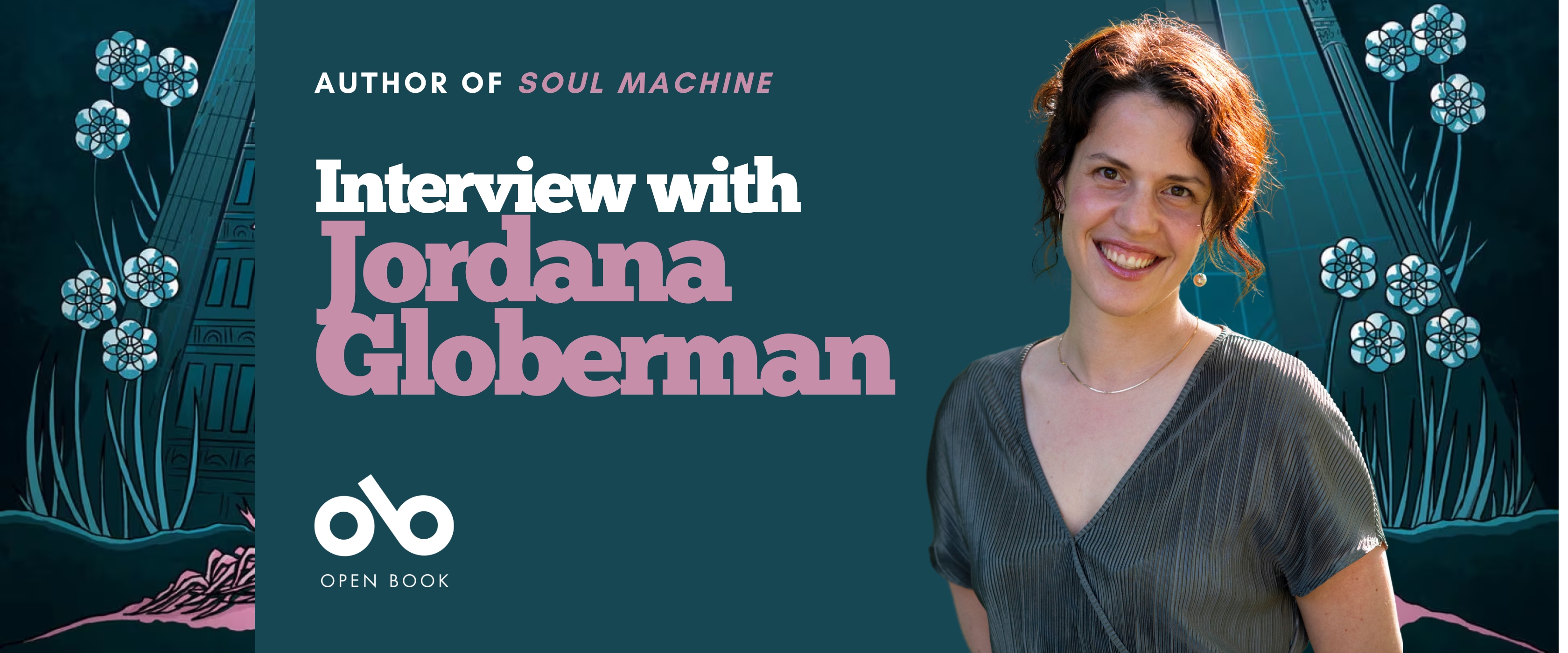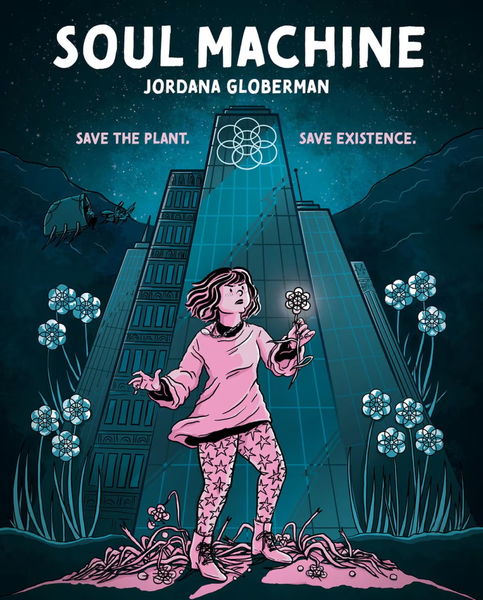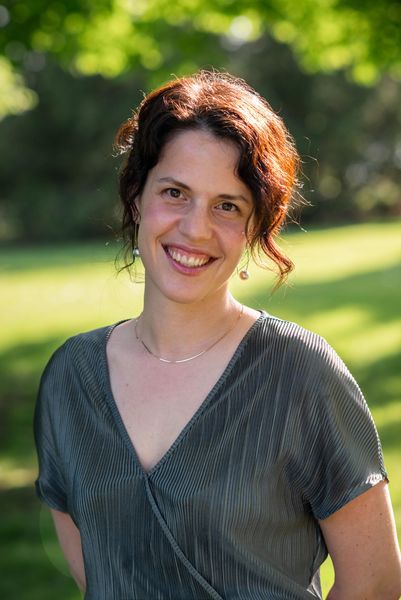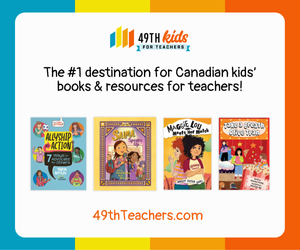Jordana Globerman Makes a Stunning Debut with the Beautiful and Heady Graphic-Novel, Soul Machine
Comic book writer and illustrator Jordana Globerman makes a stunning debut this season with her new graphic novel, Soul Machine (Annick Press). It's a profound and stirring work that is being billed as A Wrinkle in Time meets Brave New World, which suitably captures its mix of youthful adventure with explorations of existential and societal themes.
In this fascinating new book, Chloe and her sister Lacey, (14 and 16 years old) craft handmade souls in a derelict country house. But the mysterious material they use for this trade begins to run out, which leads to a play by the evil MCorp to force the girls into creating synthetic souls. The older sister, Lacey, will not let go of old ways and stays behind while Chloe strikes out to the big city to find another organic source for their crucial, ancestral duty. Free from the clutches of MCorp, Chloe uncovers some of their buried family secrets, and begins to question everything she thinks she's known about their lives and reality itself.
This metaphysical sci-fi story is buoyed by beautiful artwork and elements that ring true outside of these pages. Like all of the best storytelling for young readers, the creativity and imagination on display intertwines with provocative ideas, such as spirituality, family, and reality and the rampant consumption and corporate greed that dominates our lives.
Open Book:
Tell us about your new book and how it came to be.
Jordana Globerman:
Soul Machine is the story of one girl’s quest to save her family’s business, and existence itself. It follows the main character, Chloe. When the story begins, she is living with her sister, Lacey, in an old house in the countryside. They spin a natural fibre from a plant called breth into the fabric that makes up souls. A big corporation, MCorp, threatens to run them out of business just as the breth supplies go scarce and this sets Chloe off on a quest to find more of the plant. Along the way she meets many characters that push her to question her upbringing, beliefs and the mysteries that make up her existence. I began writing Soul Machine on maternity leave with my first chid. It was during the height of the pandemic and I was thinking a lot about society, our digital addiction and the isolation permeating society. At the same time, I was thinking a lot about life—where we come from and where we go to—in a bit of a spiritual fashion. This all blended together into the philosophical essence of Soul Machine.
OB:
What, in your opinion, is unique about writing an illustrated project, as opposed to a text-based book? What opportunities, and what challenges, do the combination of visuals and text provide?
JG:
You have to think about the story on two levels: What do you want to say? And do you want to say it or show it? When I worked with my editor Serah-Marie McMahon (who is brilliant by the way), we would often go over pages and think: “Is there a more elegant, metaphorical way of depicting the essence of what is being said here, rather than just plunking it in dialogue?" I think a graphic novel presents huge opportunities for storytelling because you can evoke so much emotion through visual metaphor, which adds another dimension to the text. That said, it is also a challenge because the visual component demands a cinematic consideration of the text, so you become way more focused on things like pacing and continuity. If something should be shown rather than explained through text, it’s immediately evident and missing this can throw off the whole pacing of a scene. Likewise, if you try to only show certain things, it can be hard for a reader to understand what is actually happening, especially when there is a lot of action. It’s a fine balance!
OB:
Did your book turn out similar to how you original expected it to, or did it change during the creative process?
JG:
It changed a lot! This is my first published, full-length graphic novel so I had a lot to learn, and I learned it while writing it. I worked a lot to improve the mechanics of Chloe’s universe, her character arc, the arc of relationships between characters, and the stakes throughout the plot. I cannot say enough how important it is to work with a good editor, or even a friend or colleague who is a good reader. It helps so much to share your work and have someone poke holes in it, so that you can figure out where you need to work a bit harder. In art school, you often have art “crits”—a sort of salon framework where you share your art and receive constructive criticism. Likewise, any opportunity to gain criticism will help you as a graphic novelist. It’s so hard to get distance from your own work and listening to readers is a fantastic way to figure out how to improve. Even a seemingly subjective take can reveal something essential about your art and can help you to grow as an artist.
Your CanLit News
Subscribe to Open Book’s newsletter to get local book events, literary content, writing tips, and more in your inbox
OB:
Is there a character in your book that you relate to? If so, in what ways are you similar to your character and in what ways are you different?
JG:
I think I relate to all of them. When I was a bit younger I think I really had Chloe’s impetuous streak and I hope I still have her curiosity. I think sometimes I have Lacey’s fear. Hopefully I have Maya’s fashion sense (and nothing else of hers). I think you need to relate to a character to conceive of them and to write them in a way that feels real, whether or not you agree with their decisions or perspective.
OB:
Is there something you hope readers get from reading your book or a subject you hope to bring more attention to that is contained in your story?
JG:
I hope readers glean the importance of critical thought and authentic decision-making from this book. We live in an increasingly divided world, where so many of our opinions are fed to us from social media or our in-group. A world with more dialogue and less division can only be brought about by people taking the time to understand and empathize with each other and where decision-making comes from authentic belief and engaged analysis, rather than osmosis. Chloe is presented with a lot of different perspectives, all forceful and all myopic, and in the end she is able to find her own way, guided by the love she has for others, rather than ideology.
OB:
How do you see your artwork and your text working with and informing each other in this project?
JG:
The artwork and text really go hand in hand. I begin writing with a very loose outline, but when it really gets down to a script I am already working with both text and image. I start with very rough thumbnail sketches—like a story board—that way both words and pictures are being considered holistically. I tried to capture some of the thematic elements of the text in the media I selected for my artwork. I used a mix of digital drawing and hand-painted and printed textures for my pages. The visual tension between digital and analogue is meant to echo the tension between digital and natural elements in the book’s themes.
OB:
What do you need in order to write and create your artwork – in terms of space, food, rituals, writing instruments?
JG:
I have two little kids, so I would literally never have time to create if any other needs came into play! All I need is my iPad and as much time as I am allowed to get into the process, plus copious amounts of coffee. Writing definitely requires a bit more focus and I do find the thought process behind writing takes a lot of space. I have gotten pretty good at multi-tasking, but for writing I need to find some time to sneak away into absolute silence to think through the complexities of storytelling.
OB:
Was there a graphic novel or comic series you read as a young adult that is particularly meaningful to you?
JG:
I loved the Wrinkle in Time series and I think it had a big impact on this book. Visually, I was obsessed with Craig Thompson’s work in high school and I love the use of line in Blankets and Habibi.
__________________________________
Jordana Globerman is a comic book writer and illustrator based in Ottawa, Canada. She holds a Masters in Visual Arts from the University of the Arts London in England, where she majored in drawing anthropomorphic bears and drinking tea the proper way.





